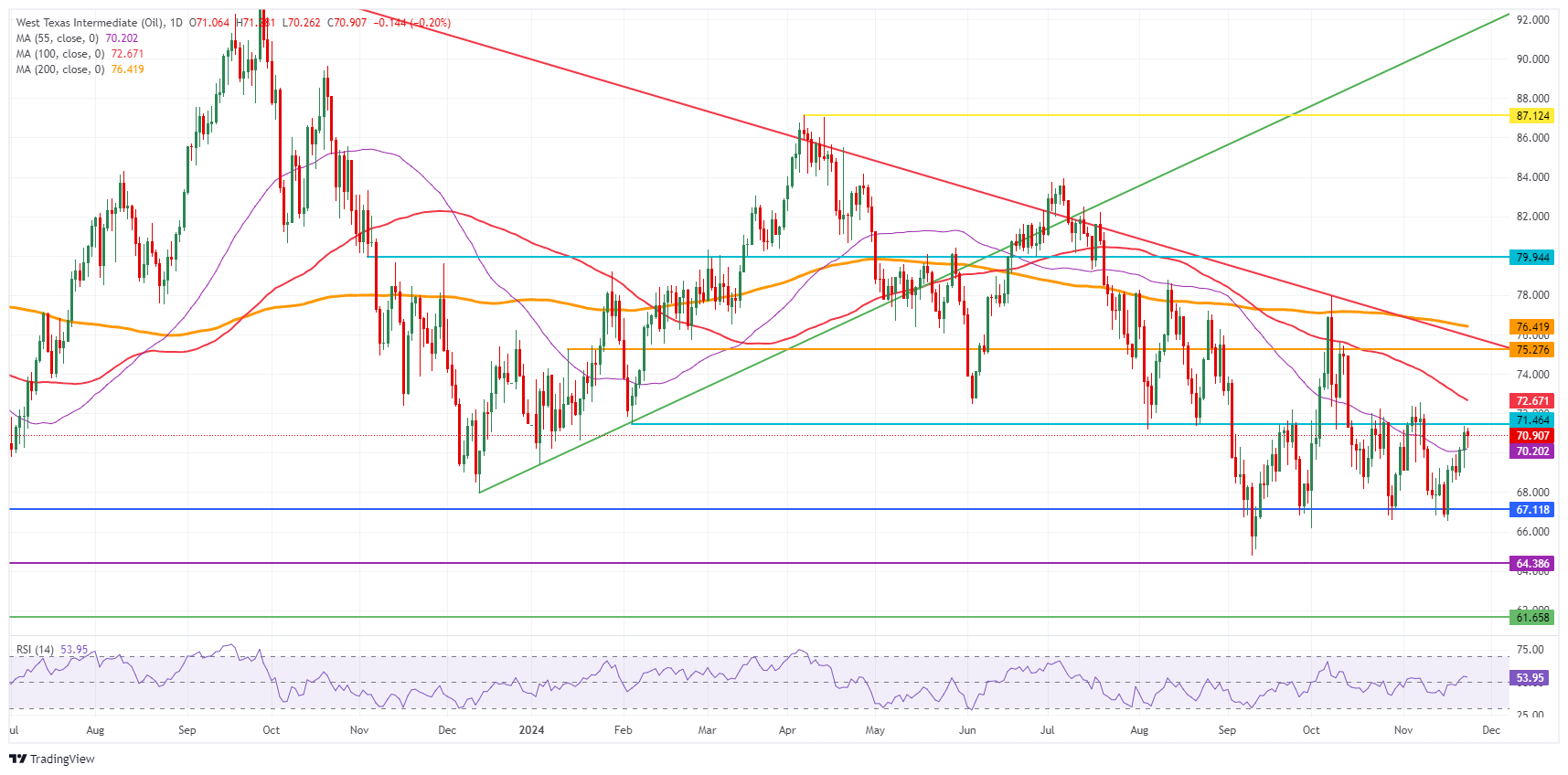- Crude oil weakens after geopolitical tensions between Russia and Ukraine eased over the weekend.
- The OPEC+ meeting on December 1 is considered crucial as a delay in production normalization is expected.
- The US Dollar Index retreats after hitting a new two-year high last week.
Crude oil is retreating this Monday, trading around $70 after a quieter weekend on the geopolitical front and ahead of a week shortened by the US Thanksgiving holiday. The focus of the week, apart from any Russia-Ukraine or Middle East headlines, will be on the OPEC+ meeting scheduled for Sunday, December 1.
Meanwhile, the US Dollar Index (DXY), which measures the performance of the Dollar against a basket of currencies, is also retreating after its spectacular performance last week. Over the weekend, President-elect Donald Trump nominated former hedge fund manager Scott Bessent for the position of Treasury Secretary. Markets perceive Bessent as a fiscal hawk, targeting a budget deficit of 3% of GDP by 2028, while indicating he supports plans for tariffs and tax cuts.
At the time of writing, crude oil (WTI) is trading at $70.67 and Brent crude is trading at $74.24.
Oil news and market factors: Risks towards the end of the week
- With the US Thanksgiving holiday on Thursday, the weekly report from the American Petroleum Institute (API) will remain on Tuesday, while the weekly stockpile change numbers from the Energy Information Administration (EIA) ) and Baker Hughes oil rig count will be released Wednesday.
- Volatility and low liquidity could be an issue on Thursday and Friday, with the historical pattern of OPEC+ members communicating their stance or opinions before the December 1 meeting, Bloomberg notes. Any comments could move oil markets through Thanksgiving and Black Friday.
- Weekly data from Vortexa shows that the amount of crude oil stored worldwide in tankers that have been stationary for at least 7 days rose to 74.83 million barrels as of November 22, an increase of 34% compared to the previous week of 55.76 million barrels in the week of November 15, Bloomberg reports.
Technical analysis of oil: Excess supply weighs on the price of crude oil
The price of crude oil is set to enter a dangerous phase ahead of one of the last OPEC+ meetings of this year. Not only is this meeting crucial in terms of when in 2025 production normalization will take place, but in the days leading up to that meeting on Sunday, US markets will be closed due to Thanksgiving and Black Friday. In this context, any market-moving commentary could see sharp moves with low liquidity and fewer market participants than normal.
To the upside, the 100-day SMA at $72.67 along with the crucial level at $71.46 just below are the two main elements acting as resistance. The 200-day SMA at $76.42 is still some way off, although it could be tested if tensions escalate further. On its rally towards that 200-day SMA, the crucial level at $75.27 could still cap any upside.
On the other hand, traders should look towards $67.12 – a level the price held in May and June 2023 – to find first support. Should it break, the 2024 year-to-date low emerges at $64.75, followed by $64.38, the 2023 low.
US WTI Crude Oil: Daily Chart
WTI Oil FAQs
WTI oil is a type of crude oil that is sold in international markets. WTI stands for West Texas Intermediate, one of the three main types that include Brent and Dubai crude. WTI is also known as “light” and “sweet” for its relatively low gravity and sulfur content, respectively. It is considered a high-quality oil that is easily refined. It is sourced in the United States and distributed through the Cushing facility, considered “the pipeline junction of the world.” It is a benchmark for the oil market and the price of WTI is frequently quoted in the media.
Like all assets, supply and demand are the main factors that determine the price of WTI oil. As such, global growth can be a driver of increased demand and vice versa in the case of weak global growth. Political instability, wars and sanctions can alter supply and impact prices. The decisions of OPEC, a group of large oil-producing countries, is another key price factor. The value of the US Dollar influences the price of WTI crude oil, as oil is primarily traded in US dollars, so a weaker Dollar can make oil more affordable and vice versa.
Weekly oil inventory reports published by the American Petroleum Institute (API) and the Energy Information Agency (EIA) influence the price of WTI oil. Changes in inventories reflect the fluctuation of supply and demand. If the data shows a decline in inventories, it may indicate an increase in demand, which would drive up the price of oil. An increase in inventories can reflect an increase in supply, which drives down prices. The API report is published every Tuesday and the EIA report the next day. Their results are usually similar, with a difference of 1% between them 75% of the time. EIA data is considered more reliable since it is a government agency.
OPEC (Organization of the Petroleum Exporting Countries) is a group of 13 oil-producing nations that collectively decide member countries’ production quotas at biannual meetings. Their decisions often influence WTI oil prices. When OPEC decides to reduce quotas, it can restrict supply and drive up oil prices. When OPEC increases production, the opposite effect occurs. OPEC+ is an expanded group that includes ten other non-OPEC member countries, including Russia.
Source: Fx Street
I am Joshua Winder, a senior-level journalist and editor at World Stock Market. I specialize in covering news related to the stock market and economic trends. With more than 8 years of experience in this field, I have become an expert in financial reporting.








